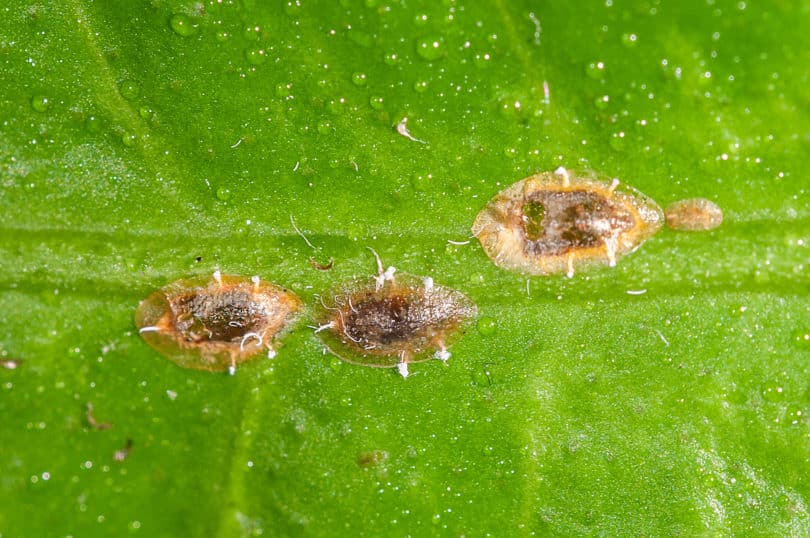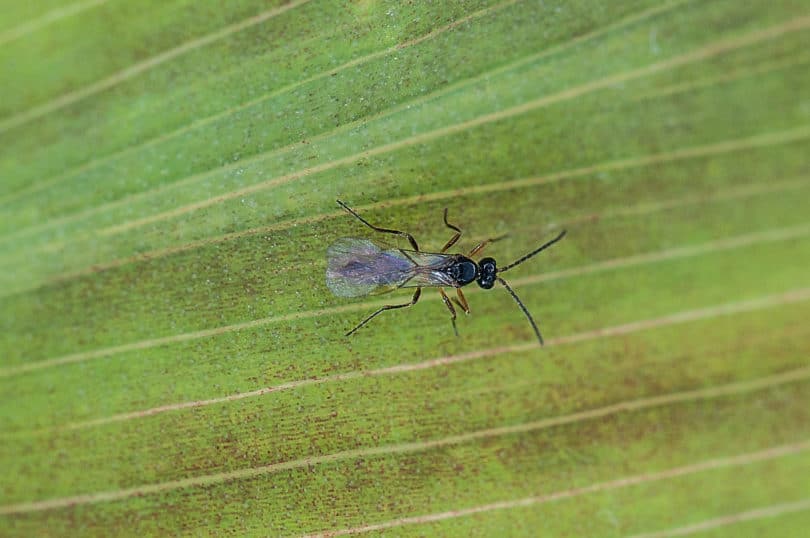Die Schlupfwespe Trichomma enecator bei der Paarung. Dieser Parasitoid parasitiert den Apfelwickler (Cydia pomonella)
Schlupfwespe
Parasitierte Napfschildlaus
Parasitierte Napfschildläuse Bei der linken und rechten parasitierten Napfschildlaus ist die Schlupfwespe bereits geschlüpft.
Aphidius colemani – Schlupfwespe
Wissenschaftlicher Name: Aphidius colemani VIERECK Volksnamen: Schlupfwespe Synonyme: Aphidius aphidiphilus Benoit Aphidius huebrichi Brèthes Aphidius leroyi Benoit Aphidius platensis Brèthes Aphidius porteri Brèthes Aphidius transcaspicus Telenga Familie: Hautflügler (Hymenoptera) Schädlinge gegen die Aphidius colemani angewendet wird: verschiedene Blattlausarten, Schwarze Wickenlaus (Aphis craccivora), Efeublattlaus (Aphis hederae), Grüne Gurkenblattlaus (Aphis gossypii), Oleanderlaus (Aphis nerii), gefleckte Gewächshausblattlaus (Aulacorthum circumflexum), Grosse Zwetschgenblattlaus (Brachycaudus cardui), Grüne […]
Venturia canescens
2013 Foray, V.; Henri, H.; Martinez, S.; Gibert, P.; Desouhant, E. (2013): Occurrence of arrhenotoky and thelytoky in a parasitic wasp Venturia canescens (Hymenoptera: Ichneumonidae): Effect of endosymbionts or existence of two distinct reproductive modes? European Journal of Entomology 110 (1): 103-107. [ad name=“A“] 2012 Belda, C.; Riudavets, J. (2012): The influence of the rearing […]
Trichogramma evanescens
2013 Watanabe, M.; Kageyama, D.; Miura, K. (2013): Transfer of a parthenogenesis-inducing Wolbachia endosymbiont derived from Trichogramma dendrolimi into Trichogramma evanescens. Journal of Invertebrate Pathology 112 (1): 83-87. [ad name=“A“] 2012 Mandour, N. S.; Sarhan, A. A.; Atwa, D. H. (2012): The integration between Trichogramma evanescens West. (Hymenoptera: Trichogrammatidae) and selected bioinsecticides for controlling the […]
Trichogramma dendrolimi
2013 Gao, Y.; Xie, C.; Wang, G.; Yu, H.; Yu, R.; Zhang, S. (2013): Study on the effectiveness to control Notodontidae in Populus * euramericana by releasing Trichogramma dendrolimi in Northern Jiangsu Area. Journal of Nanjing Forestry University. Natural Sciences Edition 37 (2): 92-96. [ad name=“A“] Li, Y.; Dong, H.; Cong, B.; Qian, H.; Yang, […]
Metaphycus stanleyi – Schlupfwespe
Wissenschaftlicher Name: Metaphycus stanleyi COMPERE Volksnamen: Schlupfwespe, Metaphycus Familie: Encyrtidae Schädlinge gegen die Metaphycus stanleyi angewendet wird: Napfschildläuse, Weiche Napfschildlaus (Coccus hesperidum), Halbkugelige Napfschildlaus (Saissetia coffeae), Schwarze Ölbaumschildlaus (Saissetia oleae) Nützlingsverträgliche Pflanzenschutzmittel: NeemAzal-T/S Eigenschaften: Die Schlupfwespe Metaphycus stanleyi wird kommerziell zur biologischen Bekämpfung von Napfschildläusen eingesetzt. Der Nützling kann ab einer Temperatur von 18° C eingesetzt werden, wobei seine Gesamtentwicklung bei 25 °C etwa […]

